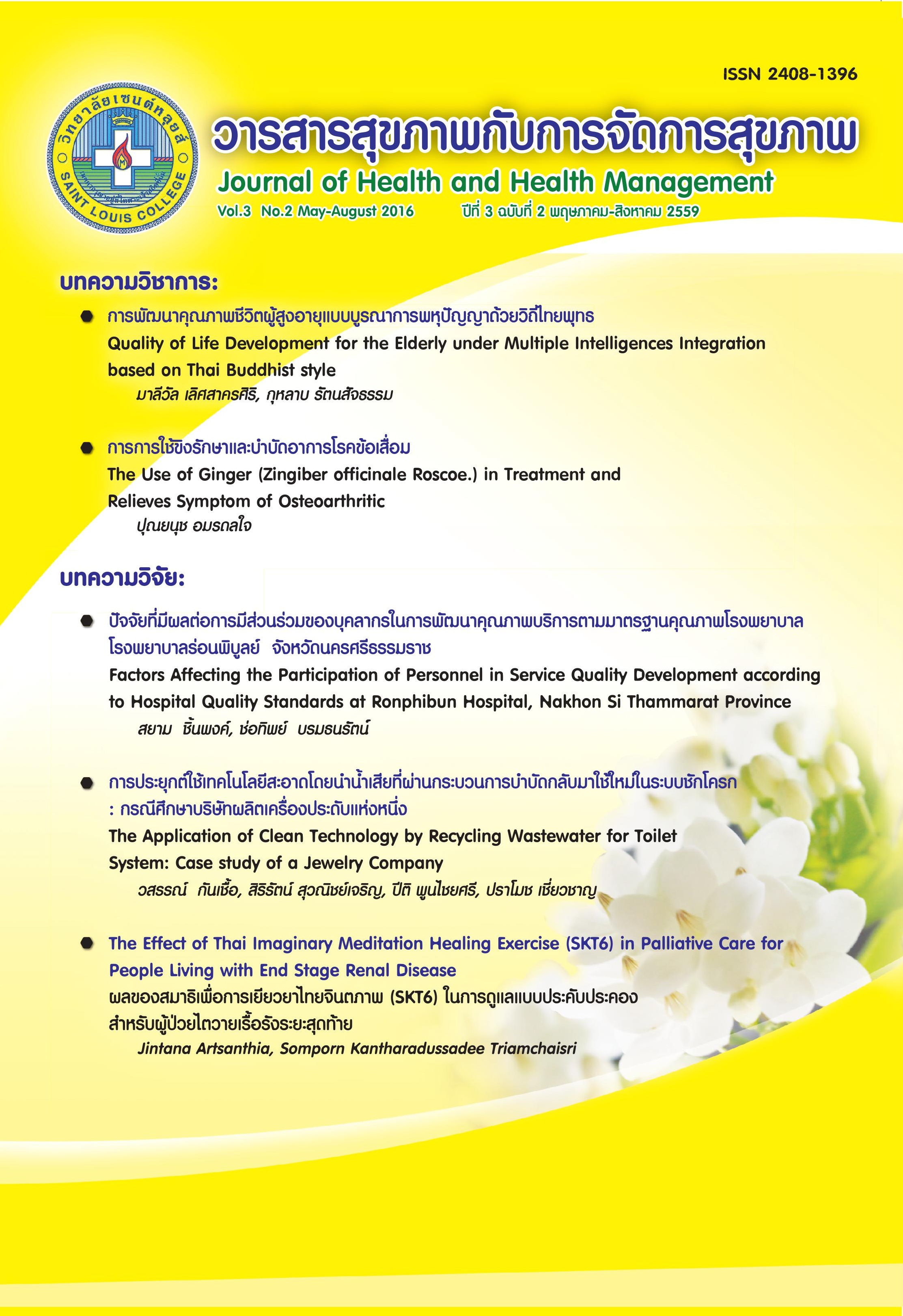The Application of Clean Technology by Recycling Wastewater for Toilet System: Case Study of a Jewelry Company
Keywords:
jewelry company, quantity of waste water, clean technology, quantity of water consumptionAbstract
This research aim to apply clean technology in order to reduce 1) the quantity of water consumption 2) the quantity of waste water 3) water charge for toilet in a jewelry company by comparing the amounts of water used, wastewater and water bill before and after applying clean technology to the company’s toilets. This quasi-experimental research was conducted for 12 weeks on a sample of toilets in two zones of the Company: 1) Production zone A and 2) Production zone B. The tools used were water gauges and water-recording forms for collecting water use data, before and after applying clean technology. Data were analyzed to calculate the amounts of water used in the toilets. Comparisons were made of the water use amounts and water bills before and after the clean technology application. The results showed that, after applying the clean technology, 1) the total water consumption decreased by 11.44%, 2) the total amount of wastewater decreased by 90%, and 3) the spending on water decreased by 45.16%. When considering the cost-benefit of the clean technology application, the investment cost will be recovered in 2 years and 5 months.
References
กรมโรงงานอุตสาหกรรม, สำนักเทคโนโลยีน้ำและการ จัดการมลพิษโรงงาน. (2550). หลักปฏิบัติ เทคโนโลยีการผลิตที่สะอาด (การเพิ่มประสิทธิภาพ การผลิตและการป้องกันมลพิษ) อุตสาหกรรมนม และผลิตภัณฑ์นม. กรุงเทพมหานคร: สำนักงาน เทคโนโลยีสิ่งแวดล้อม กรมโรงงานอุตสาหกรรม.
กรมโรงงานอุตสาหกรรม, สำนักบริหารจัดการกาก อุตสาหกรรม . (2555). คู่มือ 3Rs กับการจัดการ ของเสียภายในโรงงาน. กรุงเทพมหานคร: สำนัก บริหารจัดการกากอุตสาหกรรม กรมโรงงาน อุตสาหกรรม.
จักรกฤษณ์ ศิวะเดชาเทพ. (2554). ประมวลสาระชุด วิชาการจัดการคุณภาพน้ำในโรงงานอุตสาหกรรม. นนทบุรี: สำนักพิมพ์ มหาวิทยาลัยสุโขทัยธรรมาธิราช.
จิราภรณ์ ช่วยรอดหมด. (2551). การเงินธุรกิจ. สืบค้น วันที่ 17 กุมภาพันธ์ 2558, จาก http://dusithost. dusit.ac.th/jiraporn_chu/BF_index.htm
เจตจินต์ สุทินประภา. (2553). การลดต้นทุนการผลิตของ โรงงานผลิตน้ำอัดลมโดยใช้เทคโนโลยีสะอาด (การศึกษาด้วยตนเองปริญญาวิศวกรรมศาสตร มหาบัณฑิต สาขาวิชาการพัฒนางานอุตสาหกรรม). กรุงเทพมหานคร: มหาวิทยาลัยธรรมศาสตร์.
ทวีศักดิ์ วังไพศาล. (2554). วิศวกรรมการประปา. กรุงเทพมหานคร: สำนักพิมพ์จุฬาลงกรณ์ มหาวิทยาลัย.
วิภาเพ็ญ เจียสกุล. (2546). คู่มือเทคโนโลยีสะอาดสำหรับ ประชาชน เล่ม 1, 2. กรุงเทพมหานคร: สถาบัน สิ่งแวดล้อมอุตสาหกรรม สภาอุตสาหกรรมแห่ง ประเทศไทย.
วรรณา จินดาศรี. (2544, ตุลาคม-ธันวาคม). เทคโนโลยี สะอาด. วารสารสิ่งแวดล้อม. 5(23), น. 8 –27.
สถาบันสิ่งแวดล้อมไทย, แผนกเทคโนโลยีสะอาด ฝ่าย ธุรกิจสิ่งแวดล้อม. (2543). กรณีศึกษาเทคโนโลยี สะอาด โครงการส่งเสริมการใช้เทคโนโลยีสะอาด ในอุตสาหกรรมไทย กรุงเทพมหานคร. นนทบุรี: สถาบันสิ่งแวดล้อมไทย.
สำนักงานพัฒนาวิทยาศาสตร์และเทคโนโลยีแห่งชาติ (สวทช). (2552). เทคนิคการตรวจประเมิน เทคโนโลยีสะอาด [เอกสารประกอบการฝึกอบรม เชิงปฏิบัติการ]. กรุงเทพมหานคร: สำนักงาน พัฒนาวิทยาศาสตร์และเทคโนโลยีแห่งชาติ.
Burke, G., Singh, B., & Theodore, L. (2005). Handbook of environmental management and technology. New York: Wiley InterScience, A John Wiley & Sons.
Hatano, R., Liu, R. & Solis, S. (2015). Analysis of greywater use for toilet flushing in San Francisco. Davis: University of California, Davis. Retrieved from http://watermanagement. ucdavis.edu/files/1614/3891/2386/A01_ Hatano_Lui_ESM121_FinalReport.pdf.
Ministry of Health Canada. (2010). Canadian guidelines for domestic reclaimed water for use in toilet and urinal flushing. Ontario: Health Canada.
Kirkwood, R. C. & Longley, A. J.. (1995). Clean technology and the environment. UK: Springer Science+ Business Media.




